Global forest loss has diminished since the 1990s but still remains “alarmingly high”, according to a preliminary version of a new assessment from the U.N. Food and Agriculture Organization (FAO).
The report, Global Forest Resources Assessment 2010 (FRA 2010), shows that global forest loss slowed to around 13 million hectares per year during the 2000s, down from about 16 million hectares per year in the 1990s [NOTE]. It finds that net deforestation declined from about 8.3 million hectares per year in the 1990s to about 5.2 million hectares per year in the 2000s, a result of large-scale reforestation and afforestation projects, as well as natural forest recovery in some countries and slowing deforestation in the Amazon.
Nevertheless, loss of primary forests remained high at around 4 million hectares per year during the 2000s. Primary, or old-growth, forests today account for only 36 percent of global forest cover (1.35 billion hectares), while secondary and naturally regenerating forests make up 57 percent (2.15 billion hectares). The balance — 9 percent or 264 million hectares — consists of planted forests, including industrial plantations.
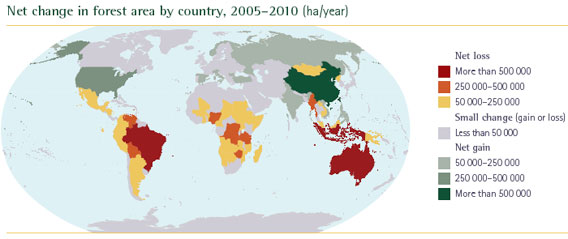
Net change in forest areas by country, 2005-2010 (hectares per year). Image courtesy of FAO.
The ongoing loss of primary forests is significant because they store more carbon and house more biodiversity than planted and regenerating forests.
FRA 2010 says that forest loss was highest in Brazil, Indonesia, and Australia, each of which lost more than 2.5 million hectares between 2005 and 2010. Myanmar (Burma), Bolivia, Venezuela, Nigeria, Congo, Tanzania, and Zimbabwe lost more than 1.2 million hectares during the period.
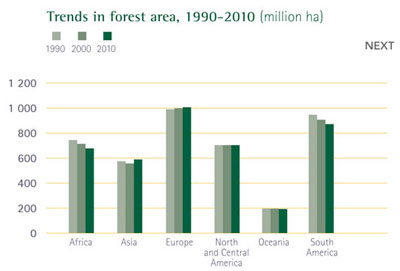 Trends in forest area, 1990-2010 (million hectares). Image courtesy of FAO. |
China saw the biggest gains in forest cover, a product of an ambitious reforestation and afforestation initiative. Primary forests in the country however continue to be diminished for plantation development, particularly in the southern China. The United States also gained net forest cover, while experiencing primary forest loss.
FRA 2010 estimates that global forest cover change between 2005 and 2010 resulted in annual loss of roughly 500 million tons in carbon stock. Overall the world’s forests store 289 gigatons (billion metric tons) of carbon, or about 37 years of annual CO2 emissions at 2006 levels.
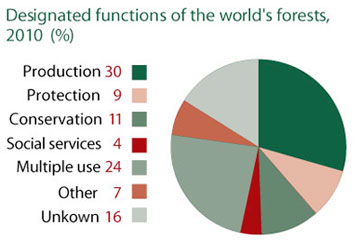 Designated functions of the world’s forests, 2010. Image courtesy of FAO. |
The assessment finds that 12 percent (460 million hectares) of the world’s forests are designated for biodiversity conservation, an increase of 95 million hectares since 1990. Legally established protected areas — national parks, game reserves, wilderness areas and other protected areas — cover 13 percent of the world’s forests. 30 percent of the world’s forests are used primarily for production and about 10 million people are employed in forest management (including logging) and conservation, although a much larger number depend on forests for their livelihoods. Globally, governments spend more on forestry than they collect in revenue, indicating that the sector is heavily subsidized, according to the report.
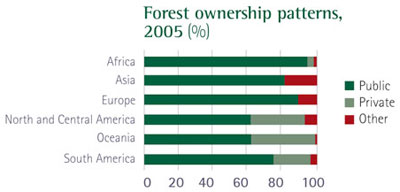 Forest ownership patterns, 2005 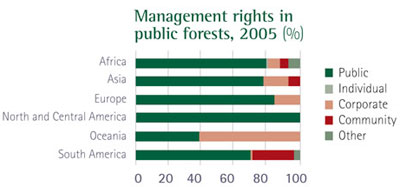 Management rights in public forests, 2005. Images courtesy of FAO. |
FRA 2010 estimates that 80 percent of forests are publicly owned, but ownership and management by communities, individuals, and corporations is increasing. Community-managed forests are most widespread in South America, while corporate management dominates in Oceania, Europe, and Asia.
The assessment reports that some 35 million hectares of forest are damaged by pests annually, primarily in the temperate and boreal zone. Roughly 1 percent or 38 million hectares was reported as being affected by fire each year, although FAO warns that forest fires are “severely underreported.”
The final version of FRA 2010 with country-by-country figures will be published in October and a new global forest map is expected by the end of the year.
FAO says that a collaborative global remote sensing survey will greatly improve its assessments by late 2011. The current assessment is based mostly on self-reporting by countries.
Related articles
Commodity trade and urbanization, rather than rural poverty, drive deforestation

(02/07/2010) Deforestation is increasingly correlated to urban population growth and trade rather than rural poverty, suggesting that measures proposed to reduce deforestation will be ineffective if they fail to address demand for commodities produced on forest lands, argues a new paper published in Nature GeoScience.
Rainforest conservation: a year in review
(12/27/2009) 2009 may prove to be an important turning point for tropical forests. Lead by Brazil, which had the lowest extent of deforestation since at least the 1980s, global forest loss likely declined to its lowest level in more than a decade. Critical to the fall in deforestation was the global financial crisis, which dried up credit for forest-destroying activities and contributed to a crash in commodity prices, an underlying driver of deforestation.
Changing drivers of deforestation provide new opportunities for conservation

(12/09/2009) Tropical deforestation claimed roughly 13 million hectares of forest per year during the first half of this decade, about the same rate of loss as the 1990s. But while the overall numbers have remained relatively constant, they mask a transition of great significance: a shift from poverty-driven to industry-driven deforestation and geographic consolidation of where deforestation occurs. These changes have important implications for efforts to protect the world’s remaining tropical forests in that environmental lobby groups now have identifiable targets that may be more responsive to pressure on environmental concerns than tens of millions of impoverished rural farmers. In other words, activists have more leverage than ever to impact corporate behavior as it relates to deforestation.
Destruction of old-growth forests looms over climate talks

(12/08/2009) Destruction of old-growth or primary forests looms large in discussions in Copenhagen over a scheme to compensate tropical countries for reducing emissions from deforestation and degradation (REDD). Some environmental groups are pressing for conservation of old-growth forests — the most carbon-dense, and biologically-rich state of forests — to be the centerpiece of REDD, while industry and other actors are pushing for “sustainable forest management” or logging using reduced-impact techniques to be the primary focus of REDD.
What does slowing economy mean for rainforest conservation?

(01/26/2009) Plunging commodity prices may offer a reprieve for the world’s beleaguered tropical forests. The global economic downturn has caused demand for many commodities to plummet. The resulting decline in the prices of timber, energy, minerals and agricultural products may do what conservationists have largely failed to achieve in recent years: slow deforestation. Fueled by surging demand from China and other emerging economies, and boosted by the convergence of food and energy markets in response to American and European incentives for biofuels, the worldwide commodity boom over the past few years helped trigger a land rush that precipitated the conversion of natural forests for farms, plantations, and ranches. At the same time, high prices for metals, fossil fuels, and other industrial resources drove a global search for exploitable reserves, many of which lie in tropical forest countries. Now that the bonanza is unwinding, with prices for everything from palm oil to bauxite to crude oil cratering, the incentives to clear forests are retreating. Developers large and small are abandoning projects and forgoing planned expansion around the world.